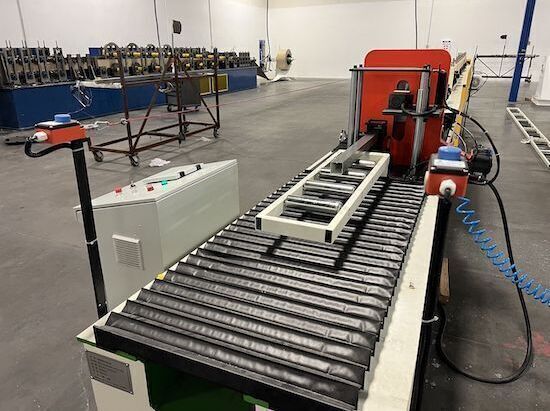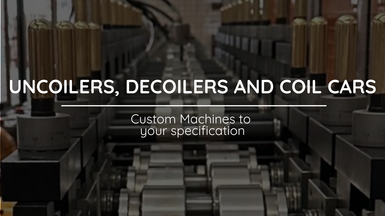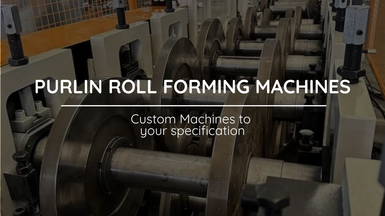
Accurate Length Control on Roll Form Cut-Offs
There is no doubt that the invention of high-speed, modern roll-forming machines has changed the landscape
Posted on Wednesday, March 29, 2023
For any industry requiring repetitive linear metal shapes to be produced en masse. The consistency of shapes created, as well as the required time it takes to manufacture them, makes investing in a roll-forming machine a no-brainer for many businesses.
However, one of the advantages of parts produced by more old-fashioned press breakers was that consistency in the length of each part was more easily achievable. While early roll formers could produce a consistent profile and parts of varying lengths, in the earliest versions, the machines would be stopped, and the sheet cut to size with a chop saw or stationary die. This impacted the efficiency of the machine and made it difficult to cut the sheet to precisely the same length each time. Variance in the timing, even by a fraction, could result in non-uniform parts.
Because of the numerous variables, the press could not be guaranteed to stop at the absolute Top Dead Center; this would, in turn, affect the timing of the following stroke as compared to the previous stroke.
Another massive variable would be the line air pressure. A large draw from the air system would often require an adjustment of the clutch's limit switch, enabling the air cylinder to move slightly sooner to help ensure the die line was up to speed. The lubrication of slides under the cut-off die, the speed of the press, and the distance the die had to travel in the downward stroke before cutting were all other factors that could result in inconsistent cut-off lengths.
However, advances in technology were made over time to ensure that more accurate length control on roll form cut-offs was possible. Roll-formed sections having more rigidity and being crafted from 20-gage material meant they could strike a preset arm as opposed to a limit switch that essentially pulled the cut-off die along with it. Because the die travelled with the section, the press was then activated. This meant lengths were accurately cut over and over again.
Advances in technology
The invention of the 1960s air press somewhat changed the game in terms of cut-off precision. Compared to mechanical presses, the speed at which air presses worked was impressive, reducing the amount of time between the roll-formed sheet striking the length limit switch and the section being cut. Because of this, a means to prevent the press from moving too far and damaging the die was crucial. Down stops were used to transfer the excess energy of the press stroke into the base - a good solution, though, resulted in the floor under the machine becoming work over time thanks to the repeated shock waves.
While air presses were advantageous in accurately cutting-off light gauge roll-formed sections at high speeds, the deterioration of the floor underneath the machine meant there could have been a better solution.
Enter high-speed hydraulics and shear blades - a combination seen on many contemporary roll formers today. A hydraulic piston attached to the shear blade controls the stroke length, which is triggered based on the length of time the hydraulic valve remains open. Because the shear blade is cut to the shape of the desired part, the length of time required for the die to travel to the shear is almost imperceptible. Being able to adjust the amount of time the valves open meant very accurate adjustments could be made.
Machine controllers then also made further refinements possible as they could compensate for many factors in the complete press cut-off cycle that could affect the accuracy of the cut.
Limit switches have also been replaced in contemporary machines, which now use Rotary Transducers. These make contact with the material with a precisely sized wheel, driving a finely graduated optical reader while the material passes underneath. Doing so can produce length accuracies of +/- 1/32″
At Roll Forming LLC, we invest in quality Roll Forming machines that employ the latest technology to ensure accurate parts are produced at speed. If you are looking for a roll-forming machine for your business, browse our range of get in touch with our team today.
Roll Forming Machines LLC's New Factory
Posted on Sunday, March 23, 2025
We have relocated factories, which will be available for tours very soon.

Uncoiler, Decoiler and Coil Car Roll Forming Machine Accesories from Roll Forming Machines LLC
Posted on Sunday, November 24, 2024
Contact us today with your specifications for a custom Uncoiler, Decoiler or Coil Car at [email protected] or call us at (+1) (407) 859 1119

Stud and Track Roll Forming Machines from Roll Forming Machines LLC
Posted on Saturday, November 23, 2024
Contact us today with your specifications for a custom Stud and Track Machine at [email protected] or call us at (+1) (407) 859 1119

Cee and Zee Purlin Roll Forming Machines from Roll Forming Machines LLC
Posted on Saturday, November 23, 2024
Contact us today with your specifications for a custom Cee and Zee Purlin Machine at [email protected] or call us at (+1) (407) 859 1119